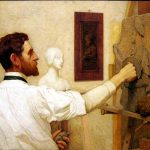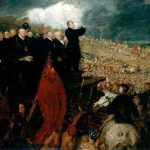
Cox’s art was very different from the cubist, neo-impressionist, fauvist, expressionist and modernist styles that emerged during his lifetime. He advocated careful drawing and modulated color, and he frequently used allegory and symbolism to present his ideas.
Kenyon Cox painted in the realistic manner and earned a reputation for landscapes, portraits and genre studies. His idealized nudes and traditional treatment of classical themes had little in common with the popular avant-garde art of the day.
Later, in 1912, Cox wrote an article for The Metropolitan Museum of Art Bulletin called “Two Ways of Painting”. In this article he describes the difference between the figurative art he was making and the more fashionable abstract art or representational art. In the article he tells of the prejudice he felt as a more traditional figurative artist:
The pressure to conformity is upon the other side and it is the older methods that need justification and explanation. The prejudices of the workers and the writers have gradually and naturally become the prejudices of at least a part of the public, and it have become necessary to show that the small minority of artists who still follow the old roads do so, not from ignorance or stupidity or a stolid conservatism, still less from willful caprice, but from necessity; because those roads are the only ones that can lead them where they wish to go.
Cox, adamantly loyal to the preservation of the “older methods”, set himself in opposition to modern styles. In his 1917 book Concerning Painting: Considerations Theoretical and Historical, Cox restated his earlier feelings about the “Two Ways of Painting” saying:
For at least fourteen thousand years, then, from the time of the cavemen to our own day, painting has been an imitative art, and it seems likely that it will continue to be so. That it should, within a few years, entirely reverse its current, and should flow in the opposite direction for thousands of years to come seems highly improbable, not to say incredible. Yet we are gravely told that it is about to do this; that, at the hands of its representative element, reached its final and definite form, and that no further changes are possible. Henceforth, as long as men live in the world they are to be satisfied with a non-representative art — an art fundamentally different from that which they have known and practiced and enjoyed.
Cox tried to persuade the art world and the public to once again appreciate traditional, representational art. His writings on the subject became very popular; however, his art did not. Source: Wikipedia.




